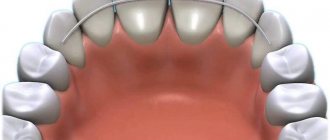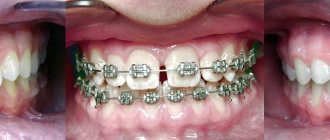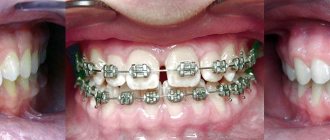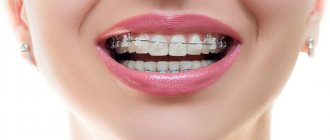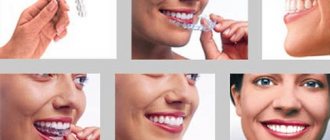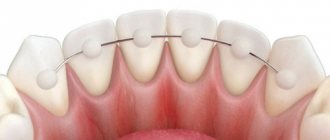Why is there a need for teeth whitening?
Orthodontic treatment can be accompanied by unpleasant surprises for unprepared patients. One of them is a change in the color of those areas of tooth enamel that were not covered with braces during treatment. After removing the system, lighter areas may stand out against the background of dark enamel.
The possibility of the appearance of such unattractive spots depends on the individual characteristics of the body and, unfortunately, cannot yet be predicted. What is known for certain is that tooth enamel darkens from smoking and consuming brightly colored foods and drinks (strong coffee, tea, etc.), as well as when basic rules of oral hygiene are not followed. At the same time, braces protect the covered areas of enamel from darkening, which is why there is a misconception about their ability to whiten teeth.
Preparation
After removing the braces, the doctor must perform professional teeth cleaning. It eliminates glue residues from the enamel, cleans teeth from plaque and tartar. If this is not done, the penetration of chemical compounds during bleaching will be difficult. As a result, the shade may turn out uneven.
Is it possible to whiten teeth after braces?
The desire to achieve a perfect smile after wearing braces for a long time is quite understandable, and tidying up the tooth enamel after treatment is completed is simply necessary. But dentists do not recommend immediately carrying out the whitening procedure, since it can become a serious test of strength for the teeth.
The action of whitening compounds used in dental practice is based on a chemical reaction. The sodium percarbonate contained in them in a fairly high concentration is activated upon contact with saliva, and the oxygen released, penetrating the enamel layer of the tooth, brightens it by several tones. To speed up the reaction, modern clinics use a laser or ZOOM device. The certain aggressiveness of the procedure can be judged by the pain experienced by some patients after it.
For this reason, to whiten the teeth of a particular patient, the dentist must use an individually prepared composition. Not only the natural color of the teeth is taken into account, but also the condition of the tooth enamel, determined through specialized diagnostics. The diagnostic result may reveal the need for a preliminary course of strengthening the enamel layer, and in some cases, an absolute contraindication to clinical whitening.
In most cases, after removing braces, you should follow a simple recommendation: postpone teeth whitening for at least a few months. Firstly, during this time, through the use of toothpaste recommended by your doctor, the depleted enamel will be restored and strengthened. And secondly, the lighter areas of the tooth surface can easily restore their natural shade on their own, and irritating contrasting spots will disappear.
Kinds
Teeth whitening is done in several ways. The doctor selects a specific method, depending on the patient’s age and the condition of his tooth enamel.
Here is a list of the most popular methods:
- special strips;
- gels and mouth guards;
- photobleaching;
- Air Flow;
- laser whitening.
It should be taken into account that in adolescents the skeletal system is still in the formative stage, and in older people the enamel is often very worn out.
Stripes
They are coated with a multicomponent gel, which contains bleaching agents. In most cases, the main component is hydrogen peroxide. The strips remove the yellowish tint of teeth and return them to their natural color. They are used at home. The products are manufactured by several companies. There are options for gentle, standard and powerful whitening.
Whitening strips are very easy to use
Gels and mouth guards
This procedure is considered to be easily accessible. It can be done either at home on your own or in a dental clinic. Many manufacturers have ready-made kits. The gels may contain the following substances:
- carbamide peroxide;
- soda or alkali;
- hydrogen peroxide;
- acids;
These components are present in concentrations that do not have an aggressive effect on the enamel. The drugs are used in combination with mouth guards. The latter are pads that need to be put on the teeth for exposure to the whitening gel.
There are three types of caps:
- Standard. They are made according to standard parameters, you need to select your size.
- Individual. Made to order based on the patient's impression.
- Thermoplastic. They are able to change their shape under the influence of heat. After heating the device and pressing it to the jaws, the resulting product exactly repeats the shape of the jaw arch and teeth.
Whitening products are available in syringes or tubes. The gel is kept for a certain period of time, which is indicated in the instructions. Next, the mouth guard is removed and the mouth is rinsed.
Advantages of the method:
- low price;
- ease of use.
Flaws:
- many contraindications;
- violation of the enamel structure (if used incorrectly).
Photobleaching
This method is widely in demand in modern dentistry. A gel containing hydrogen peroxide is distributed over the surface of the teeth. Then, the exposure is carried out with a halogen, LED or ultraviolet lamp. As a result, active oxygen is produced, which removes pigments from dental tissues.
Advantages of photobleaching:
- uniform lightening;
- instant results;
- no discomfort during manipulation;
- high degree of security;
- possibility of repeated execution (up to 6 times);
- efficiency;
- minimum contraindications;
- affordable price.
Flaws:
- duration of the procedure (more than two hours);
- the effect does not last long (for 6 months);
- increased tooth sensitivity.
Air Flow
This is a hardware procedure that allows you to lighten the enamel by one or two tones. A jet of water containing abrasive powder is applied to the surface of the teeth under pressure.
Advantages:
- painlessness;
- safety;
- the ability to clean even the most difficult to reach areas;
- absence of dental hypersensitivity after manipulation.
Flaws:
- there are contraindications (allergy to the components of the polishing mixture, bronchial asthma, diabetes mellitus and others);
- Dense old tartar is not removed.
Home whitening after braces is an unjustified risk
Using popular non-professional home whitening techniques, you can cause significant damage to your teeth. Chemical teeth whitening agents purchased at the pharmacy or recommended on online forums can destroy not only the thin layer of damaged enamel, but also the porous tooth tissue located underneath it. As a result, a patient who has spent a considerable amount on treatment with sapphire or self-ligating braces and is trying to save money on a whitening procedure may simply lose individual teeth.
Lemon
The ascorbic acid contained in lemon is beneficial not only for human gums, but also for the entire body. As for whitening with lemon, there are many options for this procedure, the simplest of which involves using one slice of a simple lemon to treat the enamel. Let’s also say a method based on adding a few drops of lemon juice to the toothpaste, which, by the way, will also help with bleeding gums.
Such products should be used carefully, no more than once a week; those who have increased tooth sensitivity should be especially careful.
Category Hygiene Published by Mister stomatolog
Pros and cons of the procedure
Whitening is a popular service in dental clinics. Like all dental services, this procedure has its advantages and disadvantages that should be considered before undergoing it.
Advantages:
- Creating a beautiful smile with white teeth.
- Removing stone and plaque prevents the development of caries.
- High efficiency.
- Duration of the result.
Flaws:
- There is a high risk of increased tooth sensitivity.
- After the procedure, it is necessary to limit the consumption of coloring products.
- Whitening will not work on filled teeth or dentures.
What is special about Avalon polyurethane braces and what defects can be corrected with their help.
In this publication, we will take a closer look at the ligature brace systems from Cassis.
Here https://zubovv.ru/ortodontiya/breketyi/vestibulyarnyie/kompozitnyie-nadezhnyih-sposob.html we will discuss the pros and cons of composite braces.
Service price
The cost of enamel lightening will depend on the chosen method.
| Methodology | Cost for 1 procedure, rub. |
| Photobleaching | 5000-10000 |
| Laser whitening | 10000-15000 |
| ZOOM | 15000-20000 |
| Set of gel and mouth guard | 3000-6000 |
| AirFlow Cleaning | 1500-3000 |
The following factors may influence the total cost:
- Initial shade.
- The number of procedures required to achieve the desired result.
- Type of clinic.
- Region of residence.
- Materials used.
How to brush teeth with braces?
We will tell you step by step the whole process of how to properly brush your teeth with braces with a toothbrush:
- First, use a V-shaped brush to clean the surface of the teeth on which the orthodontic structure is installed. We position the cutout so that the braces are inside. Cleaning is done with horizontal movements from side to side.
- At the second stage, you need to clean the side of the dentition (external or internal) to which the braces are not glued. You can use a regular toothbrush to clean it. You need to clean with sweeping movements from the gums to the edge. Also, with a regular brush, you need to carefully clean the chewing surfaces of the teeth without touching the parts of the orthodontic apparatus.
- The next stage is to remove dental plaque around each bracket and from the surface of the adjacent tooth using a circular motion with a mono-beam brush. Also, using a mono-beam brush, carefully clean the periodontal sulcus.
- Next, take a brush and place it under the metal wire. By rotating the brush clockwise, remove food debris and plaque from the interdental spaces and contact surfaces.
This ends the cleaning of braces with brushes. The next steps are super floss, irrigator and rinse.
What do you need to clean your braces?
For high-quality cleaning of such a complex structure as braces, one toothbrush will not be enough. Moreover, a regular brush that you use to clean the surface of your teeth is not suitable for caring for orthodontic appliances.
High-quality cleaning of braces and teeth must be comprehensive, and several products can provide this.
- Brush with V-shaped bristles.
It seems to bend around the plates glued to the teeth, providing a tight fit and high-quality mechanical cleaning from all sides. In addition, unlike the conventional model, the V-shaped brush does not damage the structure of the system.
- Ershik.
This is a mandatory device, without which brushing teeth with braces will not only be difficult, but will also not give the desired result. Using a dental brush, it is convenient to clean teeth under the arch, around each bracket and in the spaces between teeth. Such cleaning requires more time than usual, but allows you to efficiently remove plaque even from hard-to-reach areas, and prevent the formation of plaque and caries around braces.
- Mono-beam brush.
It consists of one tuft of bristles on the handle and is suitable for cleaning individual teeth and dental structures.
- Toothpaste enriched with calcium and fluoride.
These minerals make tooth enamel stronger, resistant to mechanical stress and bacterial activity, which helps maintain healthy teeth.
- Super floss.
This is a special thread that is used to care for braces and other orthodontic devices. With its help, the interdental spaces and difficult areas around the bracket are cleaned. The procedure is labor-intensive, so it is recommended to perform it at least once a day before bed.
- Irrigator.
Dentists recommend that every patient who wears braces purchase an irrigator. This device can be portable or stationary, operates in several modes, and is equipped with replaceable attachments. It is necessary to choose a model that has special orthodontic attachments designed for cleaning braces. The essence of the device is that it creates a powerful stream of water or a special cleaning liquid that removes plaque, food debris and other contaminants from under the arch, interdental spaces, and periodontal pockets.
- Rinse aid.
Patients with orthodontic appliances in the mouth are recommended to use special rinses. They help remove residual stains and have an antiseptic effect, preventing the growth of bacteria and the formation of plaque. Some rinses soothe gums and help prevent gingivitis or stomatitis.
How to properly glue wax to braces
Wax for braces helps reduce discomfort and pain, saving mucous membranes from chafing. It is harmless to the body and does not cause allergies. In addition to wax, special silicone is used to care for braces. It holds better, lasts longer than wax and is also safe.
To apply wax or silicone correctly, follow the instructions.
- Identify
all problem areas. - Clean
thoroughly . - Dry
the area where silicone or wax is applied. - Cut
or tear off a small piece of silicone or wax. - Warm
a little and roll it into a ball. - Attach
the ball to the orthodontic archwire or clasp that is causing pain - the wax should protrude slightly in front of the brackets. - Press
well on the ball to secure it firmly. - Repeat
this on all problem areas. - renewed
during the day .
If you accidentally swallow such wax or silicone, nothing will happen, but it is better not to do it.
Reviews
After wearing braces, darkening of the enamel almost always remains. Any whitening method can effectively correct the situation.
In the comments to this article, we invite you to share reviews about different methods of teeth whitening.
If you find an error, please select a piece of text and press Ctrl+Enter.
Tags: braces vestibular braces
Did you like the article? stay tuned
No comments yet





